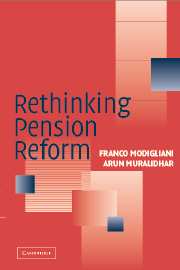Book contents
- Frontmatter
- Contents
- Preface
- Acknowledgments
- A Tribute to Franco
- Rethinking Pension Reform
- 1 A Primer on Pension Reform
- 2 A Taxonomy of Pension Reform Issues
- 3 An Evaluation of Pension Reforms
- 4 Welfare Costs of Defined Contribution Schemes
- 5 The Transition from PAYGO to Funding with a Common Portfolio: Application to the United States
- 6 Social Security Reform in Spain
- 7 The “Two-Pension Fund” Theorem
- 8 The Case for Mixed Systems and Variable Contributions: Improving the Performance of Pension Systems
- References
- Index
5 - The Transition from PAYGO to Funding with a Common Portfolio: Application to the United States
Published online by Cambridge University Press: 22 August 2009
- Frontmatter
- Contents
- Preface
- Acknowledgments
- A Tribute to Franco
- Rethinking Pension Reform
- 1 A Primer on Pension Reform
- 2 A Taxonomy of Pension Reform Issues
- 3 An Evaluation of Pension Reforms
- 4 Welfare Costs of Defined Contribution Schemes
- 5 The Transition from PAYGO to Funding with a Common Portfolio: Application to the United States
- 6 Social Security Reform in Spain
- 7 The “Two-Pension Fund” Theorem
- 8 The Case for Mixed Systems and Variable Contributions: Improving the Performance of Pension Systems
- References
- Index
Summary
THE PROBLEM OF TRANSITION FROM PAYGO TO PARTIAL OR FULL FUNDING: IS IT WORTH DOING, AND IF SO, HOW?
There is broad agreement, as shown in Chapter 3, that the funded system tends to out perform pay-as-you-go (PAYGO) in many respects. One need not assume, therefore, that there should be an immediate switch to funding (Samuelson 1975). Participants perceive funding as superior to PAYGO because they pay a lower contribution (with lower volatility) for the same cost ratio. This is only because the rest of the (cost of) benefits are provided from the return on accumulated capital (i.e., they are made richer). Therefore, to move to funding means the capital must be accumulated first to fund the unfunded liabilities of the existing PAYGO system. This is known as the “transition problem,” and the key concerns are (i) how to do it and (ii) who should bear the cost. We will deal with these issues in general and, in this chapter, eventually apply the analysis to the United States.
How do we move from PAYGO to a (fully or partially) funded system? This is regarded as the major obstacle to moving to a capitalized system. It is widely believed that this funding would impose an intolerably heavy burden on the transition generation, which would be required to pay a double contribution: one to build the new capitalized system and the other to social security (SS) to pay the current promised pensions.
- Type
- Chapter
- Information
- Rethinking Pension Reform , pp. 103 - 144Publisher: Cambridge University PressPrint publication year: 2004



